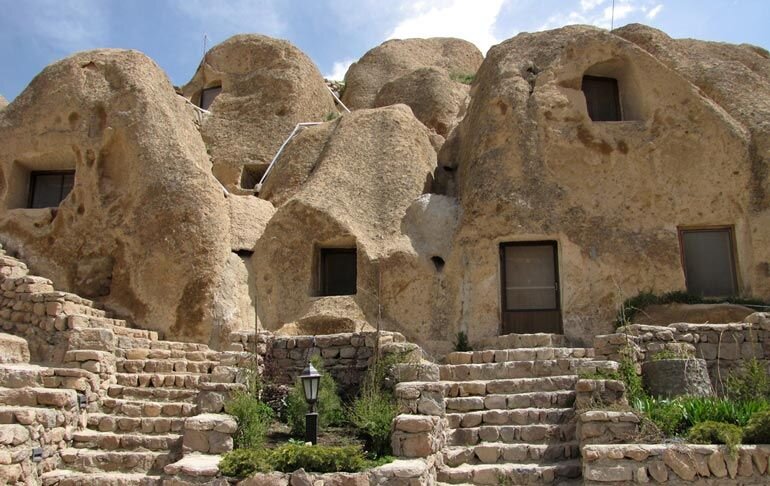TEHRAN - During the Nowruz and Eid al-Fitr holidays, Kandovan, shining in UN Tourism's tentative list of best villages, stood out as a popular tourist spot.
In an interview with IRNA, on Tuesday, East Azarbaijan’s director-general of Cultural Heritage, Tourism and Handicrafts, shed light on the remarkable tourism achievements of the historical village of Kandovan during the recent Nowruz and Eid al-Fitr holidays.
Ahmad Hamzehzadeh highlighted Kandovan's significant position as the fifth most visited village in Iran, which secured its spot after villages, Sohili in Qeshm, Javaherdeh in Ramsar, Palangan in Kurdistan, and Altappeh in Behshahr, showcasing its growing appeal among tourists.
Referring to the significant role and impact of registering the village of Kandovan on the shortlist of the best tourism villages across the world past year, the official stated, “As a result, we have witnessed an increasing number of domestic and foreign tourists to this historical village since the second half of the previous year.”
Hamzehzadeh considered the beautiful landscapes and unique views of Kandovan village as one of its most important advantages in becoming a global attraction and noted that the province’s Cultural Heritage Department planned various programs to familiarize and increase visits to this precious hamlet.
“The influx of tourists to this village,” the director-general added, “during the third wave of travel in the wake of the Eid al-Fitr holidays was very remarkable.”
Hamzehzadee also announced a 30% increase in tourist arrivals to East Azarbaijan during the Eid al-Fitr holidays.
“During these days, 1,932,000 entered East Azarbaijan,” he added, “which is a significant figure.”
Delving deeper into the local tourism landscape, Hamzehzadeh revealed that 692,817 individuals explored the various tourists, showing an 11% surge compared to the same figure of a year earlier.
Moreover, he disclosed a 13% increase in museum visits, with 44,325 enthusiasts.
“Diverse cultural and artistic programs in museums and tourist sites of East Azarbaijan,” the director-general noted, “have had a significant impact on the increase in these visits.”
Hamzehzadeh also attributed the surge in visits to the global registration of three caravanserais and the recognition of the historical village of Kandovan as one of the best tourist villages in the world.
Despite the surge in tourist traffic, Hamzehzadeh commended the province's efforts in ensuring road safety, reporting a 17% reduction in road accidents during this year's Eid al-Fitr holidays compared to the previous year.
Located some 60 kilometers southwest of Tabriz, Kandovan is celebrated for having a magnificent rocky architecture which is the result of volcanic activities and hand-carved structures. The village was registered on Iran’s National Heritage list, and it has a worldwide reputation and is the only rocky village in the world that is still inhabited.
It’s known as Kandovan because the rocky houses in this village look like hives. It has been said in the history of Kandovan that the first group to settle in the region were residents of a village called Hilevar, two kilometers away from Kandovan. They migrated to this area escaping from Mongols and started to carve the Karans to build themselves a safe refuge.
The history of this wonderful village dates back to 6000 years ago. Some researchers on archeology have estimated its age up to 7000 years old.
The village architecture is one of its wonders; the thickness of its walls reaches two meters in some places. The rock acts as an energy-efficient material, keeping the house cool during summer and warm during winter. The heights of these rocks are about 40 meters.
There are sharp pyramidal cliffs with holes on their irregular surfaces in this village which have been created due to volcanic eruption in the region of the Sahand Mountain Range. The cliffs have shaped hive cells which are also known as Karan. Generally, most of these Karans are two-story in some cases, three and even four floors and they are not related to each other from the inside.
The inhabitants carved every room of the cliff houses like kitchens, halls, and even pens out of stone to make windows for the rooms and later, to decorate them with colorful glasses.
Since the Kandovan is located on the slopes of the Sahand Mountains, it has a great climate and there is plenty of greenery and landscapes around it. The fruitful plains of the region provide nomads with the possibility to breed honey bees and grow medicinal herbs, both are sources of income for the locals. The people of this village are mostly farmers and ranchers.
Honey is the most famous souvenir of Kandovan. Apricots and sour cherries, dried fruit, rugs, and jajim are other souvenirs of Kandovan.
The best season to visit Kandovan is spring and summer. Visiting this village will take two hours up to one day.


No comments:
Post a Comment